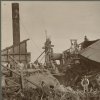breakwake_
Mr
- Joined
- Jan 3, 2018
- Messages
- 433
- Reaction score
- 345
These posts are Cornish related, about the Cornish outside of Cornwall.

Map the Miner, also known as Map Kernow or the Son of Cornwall, is a 7-metre (23 ft) statue commemorating the Cornish mining history of the town of Kapunda in South Australia. Built by Ben van Zetten, the statue stands to at the southern entrance to the town, and is regarded as one of Australia's Big Things. The statue was destroyed by fire in 2006, but it was rebuilt and rededicated 12 months later.

Map the Miner, also known as Map Kernow or the Son of Cornwall, is a 7-metre (23 ft) statue commemorating the Cornish mining history of the town of Kapunda in South Australia. Built by Ben van Zetten, the statue stands to at the southern entrance to the town, and is regarded as one of Australia's Big Things. The statue was destroyed by fire in 2006, but it was rebuilt and rededicated 12 months later.


